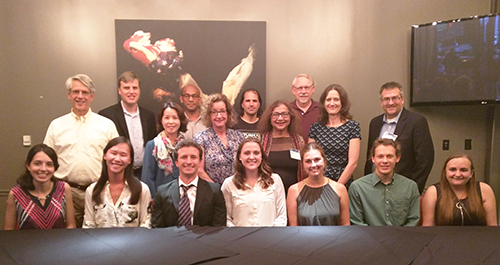
August/September 2019 (Volume 28, Number 8)
Seven Apker Award Finalists Show Off their Research Skills
By Leah Poffenberger
On August 9, APS hosted seven of the nation’s brightest young physicists for the annual Leroy Apker Award Selection Meeting. All of the Apker Award applicants boast an impressive resume of physics research at an undergraduate level, which they presented to a committee of distinguished physicists.
Previous Apker Selection Meetings have featured six finalists, three from PhD granting institutions and three from non-PhD granting institutions, but this year the committee made room for a seventh finalist—a testament to the talent of this year’s field. Research topics ranged from the physics of the cosmos to the behavior of nanostructures.
The 2019 Apker Award finalists are: Tali Khain (University of Michigan), Dolev Bluvstein (University of California, Santa Barbara), Wenzer Qin (Johns Hopkins University), Lauren Zundel (University of New Mexico), Emily Churchman (Texas Lutheran College), Katelyn Cook (Houghton College), and Kai-Isaak Ellers (Amherst College).
The finalists each received a 2000 honorarium, a 1,000 award for their undergraduate physics institutions to support future undergraduate research, travel reimbursement, and a certificate. The two winners, selected by the committee, will receive an additional 5,000 award and 5,000 for their undergraduate physics departments. The winners will also receive funds to travel to an APS meeting to give their own invited talks.
“Each of the finalists is already a winner,” Laura Greene (National High Magnetic Field Laboratory and Florida State University), chair of the selection committee, emphasizes. “They’ve all done incredible work and should be proud to reach this stage.”

LeRoy Apker Award finalists (front row): Tali Khain, Wenzer Qin, Dolev Bluvstein, Emily Churchman, Katelyn Cook, Kai-Isaak Ellers, Lauren Zundel; and selection committee (back row, L-R): Roger Falcone, Geoffrey Lovelace, Eun-Ah Kim, Sujit Datta, Laura Greene, Nima Arkani-Hamed, Talat Rahman, James Eckert, Shelly Lesher, Paul Miller.
The finalists each had thirty minutes to present their undergraduate research, display their expertise in the field, and clarify their direct contributions to the research. The selection committee then had fifteen minutes to question the presenters.
Bluvstein kicked off the selection meeting with a showcase of his work on quantum coherence in solid-state spin systems for applications in quantum sensing. Khain then discussed her contributions to plotting the orbit of objects within the Kuiper belt at the edge of the solar system and her investigations of evidence for a ninth planet.
Continuing in astrophysics, Qin presented a new formalism for characterizing gravitational waves using pulsar timing arrays and astrometry, allowing the measurement of properties beyond the capabilities of interferometers like LIGO. Zundel rounded out the finalists from PhD granting institutions with a presentation on her research of periodic arrays of nanostructures that has many practical applications, such as ultrasensitive biosensing.
After a break for lunch, Churchman was first up to share her journey in nuclear physics as part of the National Science Foundation Research Experiences for Undergraduates program. She also discussed her contributions to physics at her home institution which include building a muon detector for the physics department and participating in outreach activities. Cook, who also does nuclear physics research, came next to present her experimental work aimed at measuring low energy nuclear cross sections using internal confinement fusion, which involved building her own target chamber for testing the behavior of gas.
Ellers wrapped up the presentations with his work on enhancing coherence times in a molecular nanomagnet, Cr7Mn. His experiments point to the potential use of molecular nanomagnets as qubits for quantum computing.
The two winners, which were selected by a ten-member committee of physicists from a variety of fields, will be announced in September.
For more on the APS LeRoy Apker Award, which is made possible through an endowment donated by Jean Dickey Apker, visit the Apker Award page.
©1995 - 2024, AMERICAN PHYSICAL SOCIETY
APS encourages the redistribution of the materials included in this newspaper provided that attribution to the source is noted and the materials are not truncated or changed.
Editor: David Voss
Staff Science Writer: Leah Poffenberger
Contributing Correspondent: Alaina G. Levine
Publication Designer and Production: Nancy Bennett-Karasik
August/September 2019 (Volume 28, Number 8)
Articles in this Issue
